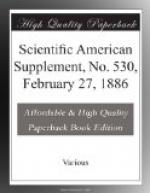C.A. Wilkes and William Millar’s improved “metallic compound for flooring, paving, and other purposes,” has for its object to provide a paving compound which is not slippery or liable to soften in hot weather, which sets rapidly, and is durable. To three parts of blast furnace slag are added one part of hydraulic cement and enough water to give the proper consistency. To each gallon of water used is added one part of bittern water—the dregs from the manufacture of sea salt—or one part of brine, or about 5 per cent. of carbonate of soda, and 21/2 per cent. of carbonate of ammonia. In the compound they sometimes use potash in the proportion of about 5 per cent. of the carbonate of ammonia and carbonate of soda, and when potash is used with bittern water or brine, the proportion of the latter is correspondingly reduced. The compound is of a blue gray color; but when a more striking color is desired, red or yellow oxide of iron may be added. When more speedy induration is necessary, they add about 1 oz. of copperas to every gallon of compound used. The claim is the admixture of bittern water, carbonate of soda, and carbonate of ammonia with the washed slag and cement.
Another improvement, by C.A. Wilkes, relates, in laying in situ any metallic or other materials for street roadways, to completing the convenience thereof by roughening or grooving the surfaces. The concrete is laid in a plastic condition upon a bed of hard core, broken stone, or preferably rough concrete. For footpaths the material may be laid in convenient sections, say 4 ft. to 8 ft. square and 2 in. to 4 in. thick; and in order to allow for the expansion of the material during the setting of the sections or subsequent variations in temperature, he packs the joints between the sections with a layer of felting cloth or other compressible material, thus forming expansion joints. Sometimes he slightly roughens the surface of the material, to give better foothold to pedestrians. Sometimes the grooving is made in imitation of ordinary granite paving sets. In tramway pavement there are grooves to give a grip to the horses’ feet, and a slight camber between the rails. He states that a great advantage in laying a pavement by the method is that, when any repairs are necessary, a piece of the exact size can be manufactured at the works, and stamped to the same pattern as the adjoining pavement, then placed at once in position on the removal of the worn portion, thus saving the time necessary for the setting of the concrete on the spot.—The Engineer.




